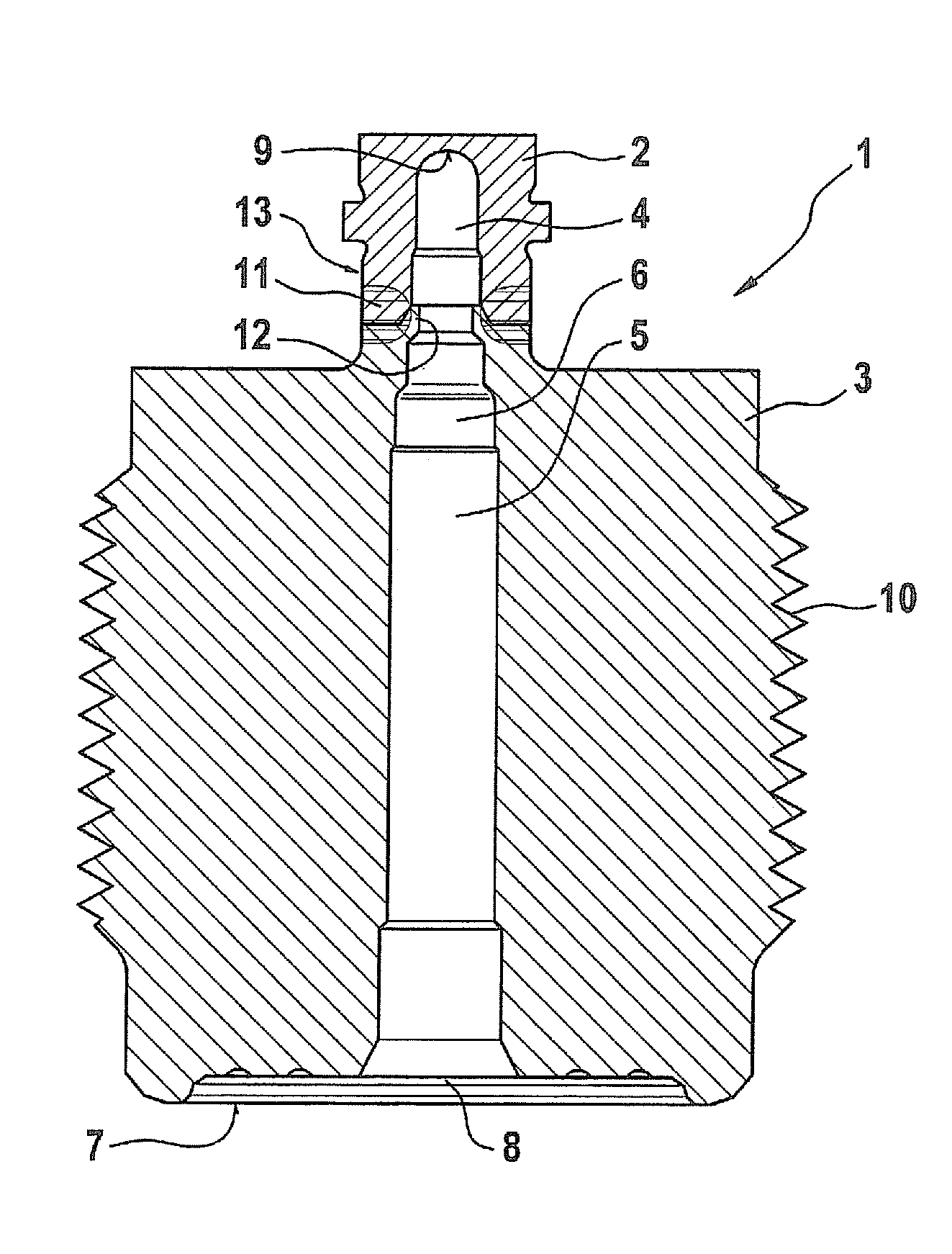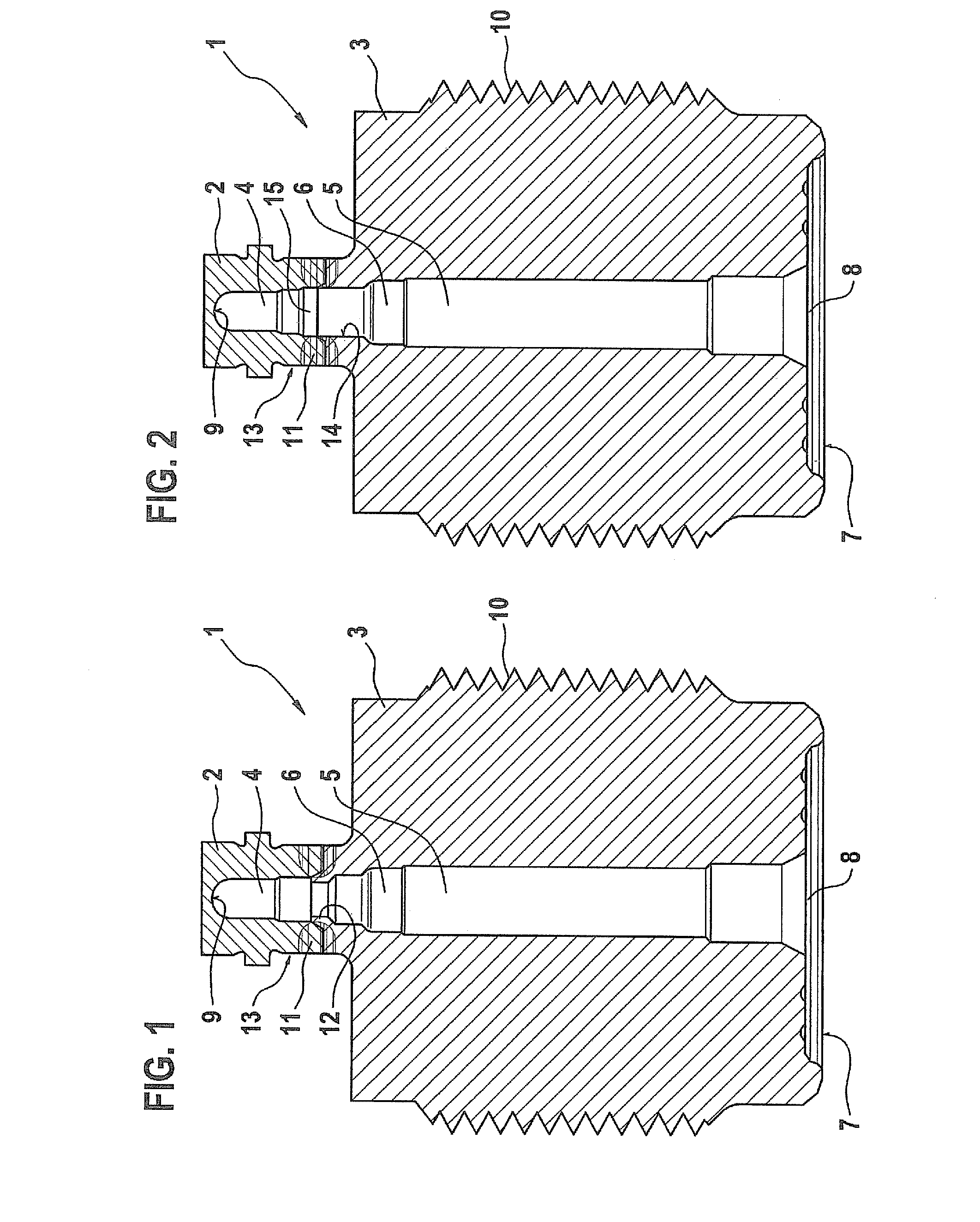[0005]A method for producing the pressure sensor assembly in accordance with the present invention may have the
advantage that the pressure sensor assembly produced is able to be used for measuring higher pressures, in particular greater than 2400 bar. According to the present invention, this is achieved by enlarging the recess of the base housing element and / or the sensor housing element by
material removal, after the welding in the area of the welding connection. In this way, stresses occurring in the welding connection, in response to the application of pressure on the pressure sensor assembly, are able to be reduced. At the same time, the separation of the sensor housing element and the base housing element is maintained, which offers cost advantages in the production. In this connection, it is mentioned that the production of a single-part pressure sensor assembly would be very costly, since the pressure sensor would have to be applied onto this single-part pressure sensor assembly.
[0006]In addition, in the case of the multi-part embodiments of the sensor housing element, it is possible to use different materials for the sensor housing element and the base housing element. In this way, additional costs can be saved and the material is able to be optimized for the respective task of the component. The material of the sensor housing element, in particular, has to have great purity, while the material used for the base housing element should be
extremely hard. In conventional methods for producing the pressure sensor assembly, a certain
weld penetration depth absolutely has to be maintained during the production of the welding seam. That is why the
weld pool backing is provided. It prevents root fusion, that is, producing a welding connection in such a way that the welding connection grasps the inner wall of the recess. The example embodiment of the present invention does away with this restriction. In addition, the geometry of the sensor housing element and / or the base housing element is able to be optimized, with respect to producing the welding seam, without restrictions, without first having to take into account the compression resistance of the finished pressure sensor assembly.
[0009]One refinement of the present invention provides that the welding take place from the outer side of the sensor housing element and the base housing element. Thus, first of all, the sensor housing element and the base housing element are positioned with respect to each other in such a way that the continuous recess is formed from the respective recesses. The recesses of the sensor housing element and the base housing element are preferably situated coaxially, in this context. Thereafter, the welding is carried out starting from the outer side of the pressure sensor assembly. A certain
weld penetration depth may be set in this context, that is, the depth to which the welding connection penetrates the material of the sensor housing element and the base housing element. It is particularly preferred to produce a continuous welding connection, that is, to weld through the material of the sensor housing element and the base housing element yielding root fusion. This makes it possible to produce a very stable welding connection.
[0010]One refinement of the present invention provides that the welding connection is produced grasping an inner wall of the recess and / or grasping the
weld pool backing. The former is provided particularly if the intention is to weld through the material of the sensor housing element and the base housing element. In this case, the welding connection extends in the axial direction from an outer wall of the pressure sensor assembly all the way to the inner wall of the recess. The root fusion can be provided with or without weld
pool backing. If weld
pool backing is provided, it may also be provided that the welding connection is not produced continuously, but only in such a way that it extends in the radial direction from the outer wall all the way to the weld
pool backing. In this way, too, a reliable and safe welding connection is able to be produced. However, as described above, the weld pool backing impairs the resistance to compression of the pressure sensor assembly. This impairment is removed, however, by material removal in the area of the welding connection.
[0012]One refinement of the present invention provides that the material removal is performed by drilling, milling and / or
electrochemical machining. In the drilling, the continuous recess is drilled out at least in the area of the welding connection. Using this procedure, greater quantities of material may also be simply removed. However, drilling is not suitable for every geometry and for every surface quality that is to be achieved. In contrast, if the material removal is made by milling, a greater surface quality may be attained. In addition, the geometry of the continuous recess may be designed comparatively freely. However, milling is connected with higher costs in producing the pressure sensor assembly. For this reason, it is advantageous if the geometry of the sensor housing element, the base housing element or the continuous recess is optimized in such a way that as small a quantity of material has to be removed as possible. Using
electrochemical machining (ECM method), almost any desired geometry of the recess may be produced, having a very good surface quality. The costs and the
processing time for
electrochemical machining are a direct function of the quantity of the material to be removed, which is why the geometry should also be optimized appropriately in this case. In electrochemical
machining, the geometry of the recess may be designed without compromise for the optimization of the
potential gradient.
 Login to View More
Login to View More 

